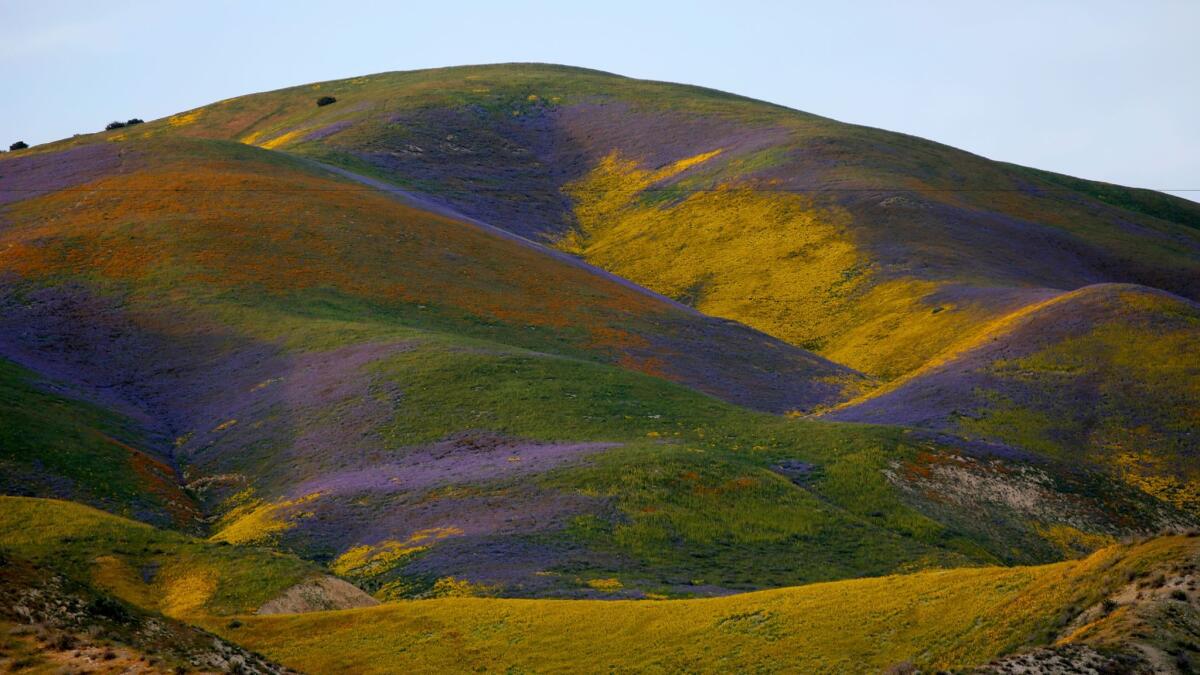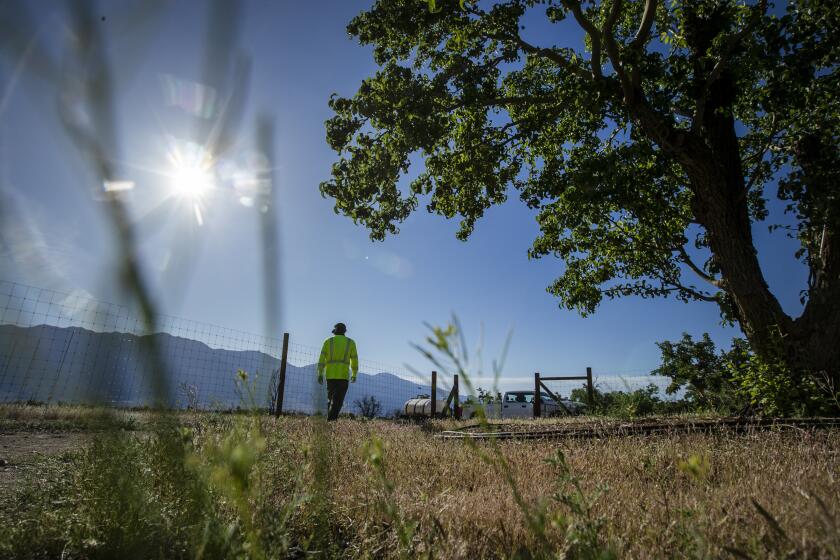Federal approval of oil well at Carrizo Plain National Monument sparks outrage

To most Southern Californians, the Carrizo Plain National Monument is best known for its stunning wildflower blooms and bone-white Soda Lake.
But to environmentalists, the plain is a well-preserved window into California’s past — a time before the sprawling grasslands of the Central Valley were overtaken by agriculture and development.
Now, those environmentalists are voicing outrage over a May 21 decision by the federal Bureau of Land Management to allow an oil well and pipeline project within the monument.
At a moment when oil prices are still reeling from a sharp decline, conservationists say the decision to open a new well is as puzzling as it is galling.
“We’re disappointed in the decision, but we’re also disappointed in how the decision was issued,” said Jeff Kuyper, executive director of Los Padres ForestWatch. “It was released on a Friday before a three-day weekend, amidst a global pandemic.”
The bureau originally approved the project in 2018, but withdrew it after Los Padres ForestWatch and the Center for Biological Diversity filed objections citing the potential for oil spills, air pollution and harm to wildlife, among other environmental concerns. Both groups said the BLM’s decision to move forward came swiftly and without warning.
“What was the rush for them to get this out?” said Lisa Belenky, senior attorney for the Center for Biological Diversity. “It’s just one more example of these federal agencies bending over backward to permit oil and gas drilling when what we need to do is stop it.”
A fantastical sea creature that uses mucus to eat planet-warming CO2 has long been a mystery of the Monterey Bay Aquarium Research Institute.
Sometimes called “the Serengeti of California,” Carrizo Plain is in San Luis Obispo County just west of the state’s largest oil field. The grassland is home to diverse wildlife and plant species, including several listed as threatened or endangered — San Joaquin kit foxes, San Joaquin antelope squirrels and Kern mallow plants among them. The decision by the BLM, a unit of the Interior Department, paves the way for the first well to be drilled on the site since its establishment as a national monument in 2001.
A representative for the BLM in California said the agency followed proper protocols in its assessment of Carrizo Plain and consulted with the U.S. Fish and Wildlife Service regarding potential effects on threatened and endangered species.
“Our analysis shows that this new well poses no undue health or safety concerns, has no significant impacts to the environment and is consistent with management directives for the Carrizo Plain National Monument,” the representative, Serena Baker, said. “America’s free markets will help determine if energy development on public lands is feasible.”
Opposition to the Carrizo Plain project echoes criticism the Trump administration has received for its approach to other national monuments. In 2017, President Trump drew the ire of environmentalists when he substantially reduced the size of Bears Ears and Grand Staircase-Escalante, two national monuments in Utah. In February, the administration opened land within those two monuments to mining and drilling. So far, they have generated little interest from energy companies, in part because of lawsuits from conservation groups questioning the constitutionality of the action.
But the outcry over the Carrizo Plain project goes further than party lines. San Luis Obispo Assemblyman Jordan Cunningham, a Republican, said in a statement that he is “disappointed in the federal government’s decision” at the site and urged officials to reconsider.
“San Luis Obispo County and California does not want or need to open up our most precious pieces of open space for additional oil drilling,” Cunningham, of Templeton, said.
Carrizo Plain’s position within Southern California also highlights diverging state and federal approaches to public land. In October, California Gov. Gavin Newsom signed a law that prohibits new oil and gas development and infrastructure on state lands; the monument’s status as federal land exempts it from that legislation.
“Why are we putting any new wells in California, or anywhere?” Belenky said. “We have to stop new production of oil and gas if we’re going to have any chance of limiting the damage of climate change.”
Living reminders of Japanese American internment at Manzanar face new threats from coronavirus.
Mining and drilling are not explicitly prohibited on public lands. Under what is known as the “multiple-use mandate,” the BLM is tasked with managing public lands for a variety of uses that include conservation and development efforts. However, monument designation is intended to signal that a specific area should be set aside for conservation.
Mark Squillace, a professor of natural resource law at the University of Colorado Law School, said the timing of the decision may have been strategic.
“Very little oil and gas development in the United States makes financial sense right now, because the cost of the production tends to exceed the value of the product,” he said. “There seems to be a lot of activity by the Trump administration to try to rush some things through before the election.”
Plans for the new well would place it at the base of Caliente Mountain, about 20 miles south of the monument’s biggest tourist draw, Soda Lake, and would involve reopening an oil pad that has been out of operation since the 1950s. The oil field where it sits, Russell Ranch, is one of the lowest-producing oil fields in the state and could be close to exhaustion.
“Our main concern is with the precedent this is going to set,” Kuyper said, adding that fossil fuel development on the site may also violate the Endangered Species Act and the National Environmental Policy Act.
The groups are reviewing their options for appealing the decision in an effort to protect the 204,000-acre monument, which has also become a popular destination in recent years for its super blooms.
“These are areas that are supposed to be set aside to protect certain natural resources in perpetuity,” Kuyper said. “Oil drilling can really interfere with the goals for which these areas were established in the first place.”








